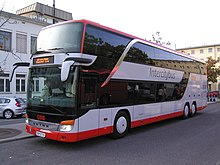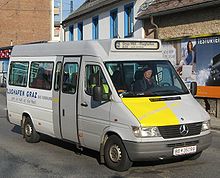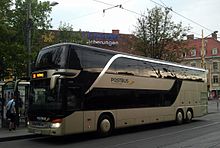ÖBB post bus
| ÖBB-Postbus GmbH | |
|---|---|
|
|
|
| Basic information | |
| Company headquarters | Vienna |
| Web presence | www.postbus.at |
| Reference year | 2013 |
| owner | ÖBB-Personenverkehr AG |
| Managing directors | Thomas Duschk Silvia Kaupa-Götzl |
| Employee | 3880 |
| sales | 408 million |
| Lines | |
| bus | 900 |
| number of vehicles | |
| Omnibuses | 2200 |
| statistics | |
| Passengers | 228 million per year |
| Mileage | 146 million km |
| Stops | 22,000 |
| Operating facilities | |
| Other operating facilities | 4 regional managements |
The Postbus is the largest bus company in Austria and operates most of the intercity bus -Netzes. The company has been a subsidiary of the Austrian Federal Railways since 2003 . Operational operations have been organized in the form of ÖBB-Postbus GmbH since October 2004 .
The Postbus operates nearly 2,100 buses and employs nearly 4,000 people. There are also around 170 buses in the subsidiaries in Austria and the Czech Republic, as well as the buses of the subcontractors throughout Austria.
The buses cover 140 million vehicle kilometers annually on almost 30,000 routes and transport 238 million passengers. The average annual turnover is 351 million euros.
history
Formerly post bus service
In 1907, the Imperial and Royal State Post set up the first motor vehicle lines. The post bus, as it was called in Austria, replaced the post coach as a means of transport in the following decades . The first post bus route in Austria was opened in what is now South Tyrol between Neumarkt and Predazzo . It still exists today under the line designation 133. The next line in the same year was Linz - Eferding , this route is still operated today by the Upper Austria regional management of the Postbus. In Lower Austria the post from 1907 to 1916 for operation together with the city of Gmünd the electrical overhead line automobile line Gmund , an early trolleybus OPERATION.
In the summer season of 1927 the Großglockner was first opened up by post bus.
In 1929 the winter traffic with caterpillar sleds was started in the Tauern .
The forced evacuation and destruction as a result of the First and Second World War largely brought traffic to a standstill towards the end of the war.
In the post-war period, the Postbus and the railway bus, which had been viewed as a competitor, shared their spheres of interest: The ÖBB buses - which were set up for rail replacement services , but then also ran regular scheduled operation - were reserved for the areas that ran parallel to the railway lines, and the Postbus for the other areas. Nevertheless, there was still parallel operation of ÖBB and Postbus on many routes.
Federal bus 1988: Postbus and train bus
In 1988, the so-called “ Federal Bus Office” was set up, the task of which was to regulate the interaction between the Postbus and the Bahnbus. The two bus companies remained largely independent. Only the new external appearance conveyed the impression, through a common paint scheme, the designation "Bundesbus" and the prefix for Bundesbusdienst, which was common from 1990 after a reform of the license plates , that Postbus and Bahnbus had been merged.
BD
Development from 1997

In 1997, after the postal administration was spun off into a private company, it was all the easier to dissolve the Bundesbus office and go separate ways. At that time, the rail bus had already been removed from the motor vehicle service (KWD) of the ÖBB due to the separation of passenger and freight traffic . The Postbus remained a part of the Post and Telekom Austria AG (PTA) until the founding of the Österreichische Postbus AG in 2000 or, after the Telekom was spun off, of the Österreichische Post AG . In 2001 it was transferred directly from Swiss Post to the Austrian industrial holding company ( ÖIAG, federal industrial holding company).
In May 2002 the Austrian federal government announced its future plans for the two own bus companies at federal level . As a result, the Postbus was sold to ÖBB (effective 2003). For reasons of personnel law, operational operations were outsourced to the new ÖBB-Postbus GmbH . Since then, Österreichische Postbus AG has only been the property owner and personnel office for the remaining federal officials. On January 1, 2005, the rail bus was also transferred to ÖBB-Postbus GmbH . In the course of the same year, part of the company was privatized through the sale of smaller regional operations:
| area | Buyers |
|---|---|
| K1 Ferlach | Carinthia Bus (Juwan) |
| K2 Völkermarkt | Carinthia bus |
| K3 Gurktal | Carinthia bus (Hofstätter company) |
| K4 Zollfeld | |
| K5 Kötschach-Mauthen and Drautal | Carinthia bus |
| K6 Mallnitz | Carinthia bus (Peitler company) |
| K7 Feistritz an der Drau | Carinthia bus (Bacher company) |
| K8 Feldkirchen | |
| N1 Zwettl / Gmünd / Waidhofen an der Thaya | not sold |
| N2 Tulln | not sold |
| N3 Neunkirchen | Retter company |
| N4 Mattersburg | |
| O1 Schärding | Glas company |
| O2 catfish | not sold |
| O3 Steyr | not sold |
| O4 Windischgarsten | Riedler company |
| S1 Hallein / Abtenau (Tennengau) | not sold |
| St1 | |
| St2 | |
| St3 | |
| St4 Mariazell | MRG (subsidiary of the Mürz Valley Transport Company ) |
| St5 Graz / Leibnitz | not sold |
| St6 Judenburg | not sold |
| St7 Murau | Retter, since May 2017 Steiermärkische Landesbahnen |
| St8 | |
| St9 | |
| T1 Matrei am Brenner | not sold |
| T2 Mayrhofen (Zillertal) | Christophorus company |
| T3 Kufstein | Inntaler Omnibus Gesellschaft (subsidiary of Ledermair) |
| V1 Schruns (Montafon) | Montafonerbahn |
| V2 Klostertal | Arlberg Express |
In 2004, under the management of Wilhelmine Goldmann, director of the board, Postbus was able to acquire the first company abroad - ČSAD Autobusy České Budějovice as in Budweis ( Czech Republic ). In 2006 (with the start of operations in 2007), the Vorarlberg regional management, under the leadership of Horst Schauerte, was able to decide on the first foreign tender for the Postbus - the bus service in the Swiss Sarganserland . The stake in the Bus Sarganserland Werdenberg AG founded for this purpose was given up again in 2009.
Corporate structure
The Postbus and Austrian Postbus AG are wholly owned subsidiaries of ÖBB-Personenverkehr AG .
Subsidiaries
Current subsidiaries
- KÖB Kraftwagenbetrieb der Österreichische Bundesbahnen GmbH , Vienna , routes in Lower Austria - operations management by ÖBB-Postbus GmbH , 100%
- ČSAD Autobusy České Budějovice as, České Budějovice (Bohemian Budweis, Czech Republic ), since 2004, 97.75%
Past subsidiaries and acquisitions
- ÖBB-Fernbus GmbH (brand name: Hellö ), is 10% owned by ÖBB-Postbus GmbH and 90% owned by the parent company ÖBB-Personenverkehr AG (operations started in mid-July 2016,soldto Flixbus at the end of May 2017 with effect from August)
- Koch Busverkehr GmbH , Horn ( Lower Austria ) and Feldkirch ( Vorarlberg ), 100% (1999 to 201x, dissolved on the recommendation of the Court of Auditors)
- Bus Sarganserland Werdenberg AG , CH-Werdenberg, 44% (October 2007 to July 2009)
- Bus Ostschweiz AG ( BOS ; merged into: WilMobil AG ), CH-Altstätten, 12% (October 2007 to July 2009)
- Gerhard Hirner GmbH , Judenburg , 100% (2001 to 200x)
Sub-brands
Current sub-brands

- Vienna Airport Lines - Three lines run every half-hour or hourly from Vienna-Schwechat Airport to the city of Vienna . A total of 13 stops are served in the city center , at Westbahnhof and in districts 2 ( Leopoldstadt ) and 22 ( Donaustadt ). The travel time is between 20 and 60 minutes, depending on the route, a special rate applies.
- Intercitybus - Since October 1, 2007, ÖBB-Postbus GmbH has been operatingthe Intercitybus between Graz Hauptbahnhof and Klagenfurt Hauptbahnhof via Wolfsberg on behalf of ÖBB-Personenverkehr AG . This line runs every two hours on the Südautobahn (A2), which is significantly shorter than the existing rail link via Leoben , and can be viewed as a preliminary operation for the planned Koralm Railway . In 2008 the Klagenfurt - Venice route was added. Are used double-decker buses in the colors of the ÖBB Intercity -vans, there is seating 1st and 2nd class and a wheelchair space. This connection is operated at the ÖBB railway tariff (see Intercitybus # tariff ).
Former sub-brands
- Emotionliner - a luxury conference bus purchased on the occasion of the centenary in 2007, which was sold again in 2009 due to lack of demand.
Rates
In terms of tariffs, the Postbuses are mainly integrated into the transport associations . A house tariff is only applied to a few lines (e.g. Vienna Airport Lines , Friedrichshafen Airport Lines , Großglocknerverkehr ).
Vehicle fleet
In 1913, the first self-produced buses (ET 13) were used and instead of the military chauffeurs used up to now, their own bus drivers were employed.
After bus production in the two large Austrian plants of Gräf & Stift (subsidiary of MAN ) and Steyr Daimler Puch (bus division; taken over by Volvo in the early 1990s ) ended in 1997, the Postbus entered the international market. The majority of the Postbus fleet comes from the manufacturer groups EvoBus ( Mercedes-Benz and Setra ), Neoman (MAN and Neoplan ), but also from Renault / Irisbus (around 180 Ares buses) and the Turkish manufacturer Temsa (around 150 Safari IC buses of various lengths).
There are also buses with gas engines in operation, from 2006 to 2010 with the Citybus in Saalfelden , and since 2007 with the St. Pölten city bus .
Painting scheme
Nationwide paintwork
- until 1979: NCS S2040-Y10R Post Cream (bright yellow) - black
- 1980–1988: RAL 1033 dahlia yellow
- Federal bus
- 1988–1990: RAL 1033 Dahlia yellow - VW L32K Phoenix red (public buses)
- 1988–1990: white - RAL 1033 dahlia yellow - VW L32K phoenix red (coaches; rare)
- 1990–1997: RAL 1033 dahlia yellow - RAL 3020 traffic red (public buses, 1991–1994 also coaches)
- 1992–1996: RAL 1033 dahlia yellow - RAL 3020 traffic red - white - gray (midibuses; rare)
- 1994–1997: white - RAL 3020 traffic red - RAL 1033 dahlia yellow (coaches; rare, but see also 1997–2000)
- 1997–2000: white - RAL 3020 traffic red - RAL 1033 dahlia yellow (like federal coach coaches from 1994–1997)
- 2000–2005: RAL 7035 light gray - RAL 1018 zinc yellow
- 2005–2011: sand quartz metallic
- since 2011: sand quartz
- since 2013: white
Today the last paintwork dominates, the Bundesbus paintwork is rarely seen. In addition to the standard paintwork mentioned, the Postbus also has vehicles in other, mostly regional paint schemes (see below) or special paintwork. For cost reasons, existing buses are usually only given a different color scheme if they need a new paint job anyway. Since the former rail buses have also been integrated into ÖBB-Postbus GmbH , buses in former rail bus paintwork (traffic red, earlier also occasionally Phoenix red) with the ÖBB Postbus logo are in use. The oldtimers have the original paintwork (mostly post cream / black, or train buses ivory / wine red), but the "street nostalgia" (ÖBB-Erlebnisbahn) also had some in the blue-gray train bus paint of the 1960s (but not on these buses authentic).
Regional paintwork
Painting of the transport associations

- Styria (starting around 1996):
- Dahlia yellow / gray / white (Postbus company color, originally approx. 6 buses)
- Traffic red / gray / white (company color rail bus , approx. 4 buses)
- Green / white (city traffic Graz), water blue / white ( Aichfeldbus )
- Signal orange / white (originally Bad Aussee summer bus, 2 buses)
- Dark blue / white (originally "Thermenbus Loipersdorf ", 1 bus)
- Yellow / gray / white (formerly 1 train bus, the Graz airport bus, otherwise company white )
- Light green / white ( RegioBus Steiermark since 2017)
- Vorarlberg (from 1998): sulfur yellow / gray or completely yellow (country bus)
- Vienna / Lower Austria / Burgenland: green / white (1 Postbus, otherwise more common, not reassigned since 2009 due to the changed corporate identity of the Verkehrsverbund Ost-Region ). Since 2016 white with green roof edge and VOR logo.
- Tyrol (from 2003): sulfur yellow
- Upper Austria: white / red
- Salzburg (SVV, from 2013): White
- Carinthia (from 2018): White with red / yellow stickers and logos from Kärntner Linien and the Province of Carinthia
Painting of the city buses
- Bregenz: blue
- Dornbirn: red
- Feldkirch: yellow
- Bludenz: Green
- Lech am Arlberg: light blue
- Kitzbühel (until 2010): Green
- Graz: green / white
- Linz: white-orange (Postbus until 2007)
- Amstetten: light blue-gray
- Krems: Green / Blue / Silver (until 2011)
- St. Pölten (from 2007, Postbus until 2017): light blue / white
- Vienna: red / gray, red / white
Curiosities
In the Motor Vehicle Act 1967 there is still the regulation that buses of the Post and Telegraph Administration may have a special following tone horn ( ):
"Devices for issuing warning signs with the tone sequence of the post horn (a-fis-ad) may be attached to buses that are intended for use in the field of postal and telegraph administration."
Since ÖBB-Postbus GmbH is legally the successor company, this regulation still applies today. Some buses are still equipped with the following tone horn. The horn is now also being produced again - digitally. On some mountain lines (e.g. the Dornbirn - Ebnit line ) the following tone horn was also used regularly to alert the oncoming vehicles acoustically to the Postbus in narrow, confusing areas.
After the Second World War , the post and rail buses initially had Vienna license plates , from 1969 PT and BB license plates, but from 1990 to 1997 BD license plates were used because of the federal bus cooperation. The number corresponds to the internal company number. In October 2002, the railway bus followed the Vienna license plate according to the scheme W xxxx BB , where xxxx is a three- or four-digit number that has nothing to do with the internal number. The Postbus has been using BD license plates again since November 2006 .
Similar services
- Kraftpost (Germany)
- Postbus (Switzerland)
- Railway bus (Austria)
literature
- Peter Lösch, Hans Pötschner: "90 Years of the Postbus". Verlag Omnibusspiegel Dieter Hanke, Bonn o. J. (1998), ISBN 3-925301-97-6 (detailed history of the Austrian post bus and its fleet from the beginning to the present)
- Horst Schaffer, Walter Schwarz: “Postbusse - new vehicles made in Austria 1947-1997.” Brief 2014. ISBN 3-20003915-9
- Alfred Rotter: "We move Austria (since 1907 ...)". Kurz, Langenwang 2004, ISBN 3-9501854-1-0 (illustrated book about the Austrian Postbus fleet from its beginnings to the present)
Web links
- Website of the ÖBB-Postbus GmbH
- Website of the Austrian Federal Railways
- Fansite about the ÖBB-Postbus GmbH
- Posthorn a-fis-ad on YouTube
Individual evidence
- ↑ Postbus partial privatization completed, in: Businessline, special no. 1/2005
- ^ Vienna Airport Lines








